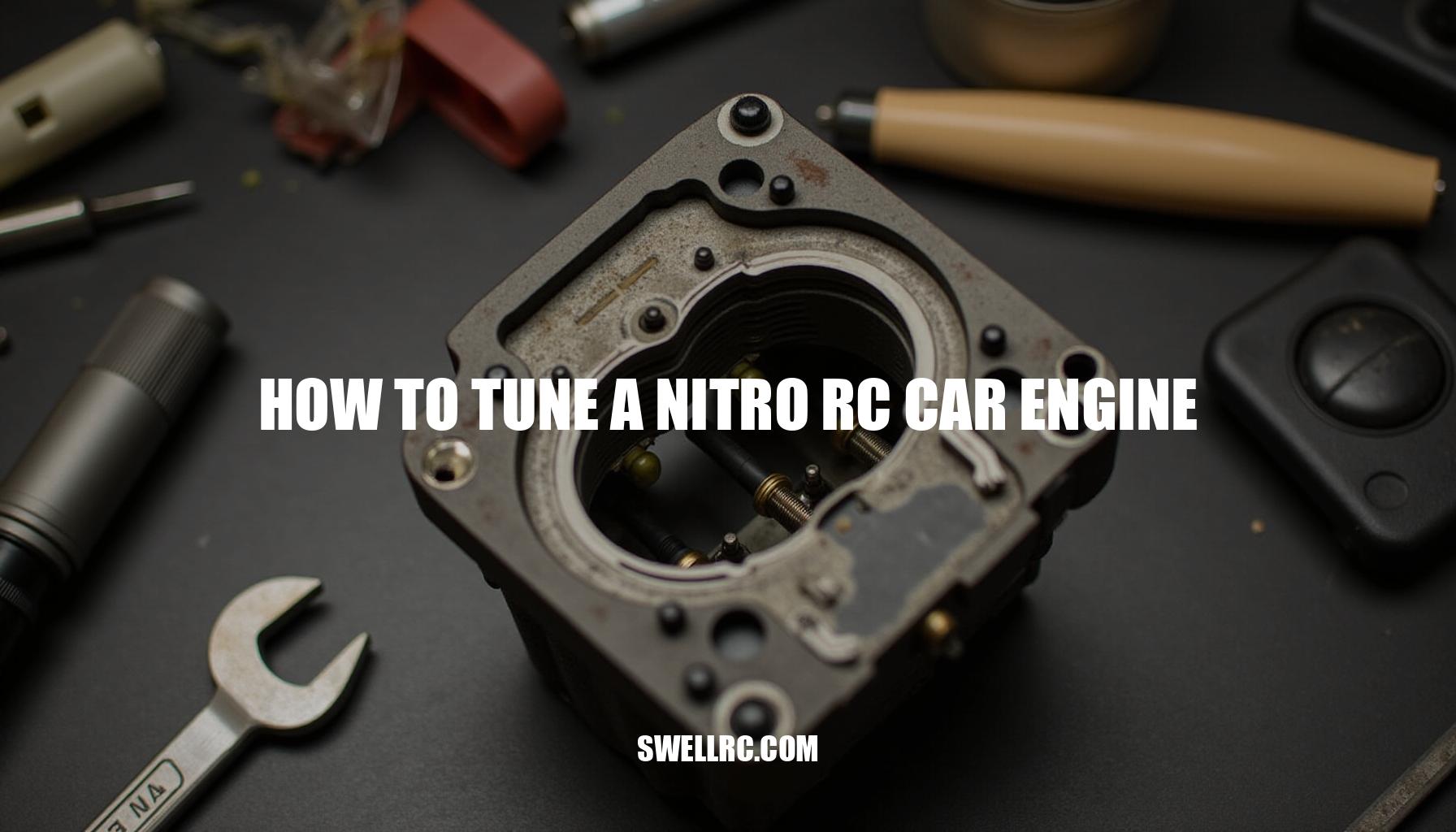How to Tune a Nitro RC Car Engine for Maximum Speed
The first time I truly learned nitro engine tuning, it was past midnight, with the garage door cracked open to let the cool air cut through the sweet, sharp smell of nitro. After dozens of late-night sessions, I finally found that magic balance: a steady 2,500–3,000 RPM idle, crisp throttle snap, and a clean, blue-tinged smoke trail under load. How to tune nitro RC engine for speed means adjusting your carburetor settings so the air–fuel mix and idle gap precisely match your engine’s needs for the day—delivering optimal RC car performance, reliability, and long life.
If you’re new to engine families and fuel systems, take two minutes to skim the basics of RC engines (https://www.swellrc.com/basics-rc-engines/) to see how nitro compares to other powerplants. By the end of this guide, you’ll be listening, smelling, and feeling your way to a perfectly dialed motor—complete with the right glow plug and tuning touches—ready to rip without risking damage.
Know Your Nitro: Carb, Needles, and What They Actually Do
Here’s the foundation I wish I had from day one for perfect carburetor settings on your RC nitro engine. Your carb has three key adjusters for precise tuning: the High-Speed Needle (HSN) meters fuel at mid-to-full throttle for optimal power delivery, the Low-Speed Needle (LSN) controls fuel from idle up to light throttle ensuring smooth acceleration, and the idle screw sets the throttle barrel opening so the engine maintains engine idle control when you’re off the trigger.
Beyond the carb tuning, achieving a healthy balance also depends on other factors like compression from a well-maintained sleeve/piston fit, the correct glow plug heat range for your environment, and using proper fuel — typically a blend containing 16–30% nitro with adequate oil to keep the engine lubricated.
| Adjuster | Function | Tips |
|---|---|---|
| High-Speed Needle (HSN) | Meters fuel at mid-to-full throttle | Adjust for maximum RPM without engine overheating |
| Low-Speed Needle (LSN) | Controls fuel delivery from idle to light throttle | Tune for smooth throttle response and prevent stalling |
| Idle Screw | Sets throttle barrel opening at idle | Maintain consistent idle speed without bogging or racing |
Proper attention to these components ensures the best performance and longevity of your RC car engine. For a deeper understanding of each part and their configuration, explore detailed RC car engine breakdowns and learn how these components fit into the bigger picture of radio control nitro cars. Don’t forget regular RC maintenance to keep everything running smoothly and reliably.
Where Everything Lives + Rich vs. Lean at a Glance
Picture the carb body on the side of the engine. The High-Speed Needle (HSN) is usually the tall needle on top of the fuel inlet, while the Low-Speed Needle (LSN) sits near the throttle arm, entering the side of the carb barrel. The idle screw touches the throttle arm stop, controlling the barrel’s resting gap (typically about 1 mm).
Exhaust exits the tuned pipe; the pressure line returns to the tank.
Understanding rich vs lean tuning explained is crucial for optimizing your nitro RC engine temperature and overall performance. Below is a cheat-sheet to help you identify the differences and ideal conditions when adjusting your carburetor settings:
| Mixture | Characteristics | Effects on Engine |
|---|---|---|
| Rich Mix | Easy starts, thick blue smoke, burbly sound | Cooler temperatures, sluggish acceleration, may load up at idle |
| Lean Mix | Harder starts, thin or no smoke, sharp note | Higher temperatures, strong power but can bog or flame out, risk of overheating or damage |
| Ideal Mix | Steady smoke under load, clean throttle response | Temperatures in the safe zone, optimal engine performance |
By carefully adjusting your carburetor settings, you balance the mixture to maintain safe nitro RC engine temperature while achieving smooth performance. Remember, a rich combination leads to cooler running but less power, whereas a lean setup maximizes power at the risk of overheating.
Use this guide to find the perfect tune that fits your engine’s needs.
Prep Work: The Methodical Setup That Makes Tuning Easy
Before you start tuning your nitro RC car, a quick pre-flight check is essential to ensure smooth operation and prevent troubleshooting headaches down the line. Follow this 5-minute routine to maintain optimal RC maintenance standards and achieve reliable performance:
- Use fresh, sealed nitro fuel: Stick with one brand and percentage of nitro fuel during tuning to maintain consistency and accurate results.
- Inspect and clean the air filter: A clogged or dry filter can drastically affect engine performance, so make sure it’s clean and properly oiled.
- Verify the glow plug and starting gear: Check that your glow plug is healthy and your starting equipment is functioning well. For troubleshooting, learn how to start an RC car without a glow plug or igniter using specialized methods.
- Warm up the engine: Drive gently for a few minutes to fully warm the engine.
Keep in mind that tuning a cold motor can lead to inaccurate adjustments.
- Perform an electronics sanity check: Confirm correct servo endpoints, ensure there’s no brake drag, and verify a centered, reliable radio link. If needed, review how to sync your RC car remote to maintain a steady connection.
Additionally, don’t overlook the proper idle gap setting on your RC car during your maintenance routine. This attention to detail combined with using quality nitro fuel and ensuring the glow plug’s condition will help keep your nitro RC car running smoothly and efficiently.
Step 1: Reset to Baseline and Warm Up
If your tune is unknown, start from factory settings for optimal nitro engine tuning. Begin by adjusting the High-Speed Needle (HSN) about 2.5–3 turns out from fully closed. Set the Low-Speed Needle (LSN) flush with the collar or according to your manual’s specifications.
Ensure the idle gap is around 1 mm for proper engine idle control. Once these carburetor settings are established, fire up the engine and bring temperatures up gradually with easy laps.
A slightly rich baseline mixture is safer at the start; from there, you can progressively lean toward performance for better power and efficiency. This approach helps maintain engine health while fine-tuning your setup.
| Adjustment | Recommended Setting | Purpose |
|---|---|---|
| High-Speed Needle (HSN) | 2.5–3 turns out from closed | Controls fuel at high throttle |
| Low-Speed Needle (LSN) | Flush with collar or per manual | Controls fuel at low throttle |
| Idle Gap | ~1 mm | Engine idle stability |
Step 2: LSN for Clean Idle and Smooth Takeoff
When performing low-speed needle tuning, the pinch test is a reliable method to gauge whether your engine idle control is set correctly. To conduct the test, at idle, pinch the fuel line about 1 inch from the carburetor. Expect the RPM to rise slightly and the engine to die within approximately 3–4 seconds.
- If the engine dies immediately, it indicates the setting is too lean.
To correct this, open the Low-Speed Needle (LSN) by 1/16 to 1/8 turn.
- If the engine gurgles and takes longer than 4 seconds to die, the mixture is too rich. In this case, close the LSN by 1/16 to 1/8 turn.
Always confirm adjustments with short launches; you should experience a crisp pull without bogging or stalling. Additionally, rich vs lean tuning explained can be observed by reading the smoke: a light haze during throttle blips is normal and indicates good tuning, whereas heavy smoke combined with sputtering suggests the mixture is too rich.
| Test Condition | Engine Reaction | Adjustment |
|---|---|---|
| Dies Immediately | Too Lean | Open LSN 1/16–1/8 turn |
| Dies in 3–4 seconds | Optimal | No adjustment needed |
| Dies after more than 4 seconds | Too Rich | Close LSN 1/16–1/8 turn |
Step 3: HSN for Power and Safe Top-End
To optimize RC car performance, make full-throttle passes on a long straight to test your settings effectively. If the engine sputters and won’t clean out during these runs, it indicates that the mixture is too rich. In this case, adjust the high-speed needle adjustment by closing the high-speed needle (HSN) by 1/8 turn and test again.
Conversely, if the engine screams, goes flat, or sags after a few seconds, it may be running lean; try opening the HSN by 1/8 turn. Throughout this process, carefully watch the temperatures and observe the smoke output. Your goal when learning how to tune nitro RC engine for speed is to achieve strong acceleration, maintain a consistent top speed, and maintain a steady smoke trail under load without spitting raw fuel.
Symptoms-to-Adjustment Quick Map + Temperature Cues
When tuning your nitro RC engine, make tiny adjustments using these sensory cues to optimize performance and longevity. Understanding rich vs lean tuning explained helps you navigate carburetor settings effectively. Use an infrared temp gun to monitor nitro RC engine temperature on the glow plug boss — most .12 to .28 engines perform best between 200°F and 270°F depending on their design and fuel type.
For more detailed insights, refer to the RC plane nitro engine setup parallels.
| Sensory Cue | Cause | Adjustment |
|---|---|---|
| Bogs off idle, loads up | LSN too rich | Close LSN slightly |
| Dies on pinch in 1–2 seconds | LSN too lean | Open LSN slightly |
| Sputters at WOT, won’t clear | HSN too rich | Close HSN slightly |
| Screams then cuts, thin smoke, hot | HSN too lean | Open HSN slightly |
| Idle races after a run | Air leak or too lean on LSN | Check seals, open LSN |
Always make these adjustments in small increments to avoid over-tuning and damaging your engine. By carefully monitoring carburetor settings alongside nitro RC engine temperature, you can ensure smooth operation and the best performance from your setup.
Advanced Tuning: Weather, Altitude, and Fuel Nuance
Air density changes everything when it comes to nitro engine tuning. Hotter temperatures or higher altitudes thin the air, so you can expect to richen the mixture slightly to maintain optimal performance. Conversely, cooler, denser air typically requires leaning the mixture to compensate.
Humidity also plays a role by enriching the mix because water vapor displaces oxygen; on muggy days, leaning the fuel slightly helps balance combustion.
Don’t forget that variables like nitro fuel brand and oil content can subtly shift needle positions. It’s essential to change only one variable at a time and make adjustments in small increments—usually between 1/16 and 1/8 turns.
| Weather and Altitude Effects | Nitro Engine Tuning Adjustments |
|---|---|
| Higher temperature / higher altitude | Rich slightly (increase fuel flow) |
| Lower temperature / lower altitude | Lean slightly (reduce fuel flow) |
| High humidity | Lean slightly (displaced oxygen reduces combustion efficiency) |
Common pitfalls in RC maintenance include chasing perfection before the engine reaches operating temperature, running too lean for marginal gains (like an extra 1 mph), and over-revving on a stand without load. Always perform tuning under load to simulate real conditions accurately.
If you’re comparing different powerplants, note how 4-stroke RC airplane engines (link) and RC gas plane engine systems (link) respond differently to mixture and temperature changes. Understanding these contrasts sharpens your nitro instincts and helps optimize performance.
Troubleshooting: Idle Gremlins, Fuel Blowback, Weird Acceleration
If you’re wondering why won’t my nitro RC car start or experiencing irregularities in your vehicle’s performance, a quick diagnostic can help pinpoint common issues related to engine idle control and overall functionality. Consider these potential problems and solutions:
- Erratic idle: This often results from air leaks. Check your carburetor O-rings, backplate, and fuel lines for any leaks.
Additionally, the low-speed needle (LSN) setting might be too lean—try opening it slightly and resealing any leaks you find.
- Fuel blowback from carburetor: Could be caused by a very rich LSN setting or damaged reed valves, one-way valves, or rotary timing components. To fix this, reset the LSN to baseline and conduct a thorough inspection.
- Hesitation after half tank: This might indicate tank foaming or clunk issues. Adding foam inside the tank, inspecting the pressure line, and checking the tank lid seal can alleviate this problem.
- Inconsistent top speed: Often due to a clogged pipe coupler, pinched pressure lines, old fuel, or high-speed needle (HSN) drift.
Replace all soft lines and rebaseline the settings for optimal performance.
- Flameouts on braking: Usually caused by the idle screw gap being too small or the LSN being too lean. Opening the idle screw slightly or richening the LSN can prevent flameouts.
Monitoring your nitro RC engine temperature during these adjustments is crucial to ensure the engine runs within safe limits. It’s also a good idea to keep a tiny notebook of changes and conditions as patterns will emerge, helping you fine-tune your engine idle control and avoid recurring issues.
Post‑Tuning Care: Lock In the Gains and Protect the Engine
Right after a good session, let the engine cool at idle for 30–60 seconds before shutdown. Drain the tank and run the engine dry to clear lines. Add a few drops of after-run oil into the carb and glow plug hole, then rotate the engine to coat internals.
Wash off grime and re-oil the air filter—see how to clean a nitro RC car for a simple routine that keeps tunes consistent.
Maintaining a regular RC maintenance schedule is crucial for optimal performance. Below is a quick maintenance rhythm incorporating the use of after-run oil, checking the air filter, and monitoring your nitro fuel usage.
| Maintenance Interval | Task | Notes |
|---|---|---|
| Every Run |
|
Ensures clean airflow and safe fuel delivery |
| Every 3–5 Runs |
|
Prevents debris buildup and maintains smooth clutch operation |
| Every Gallon of Nitro Fuel |
|
Keeps drivetrain components in top condition and ensures reliable ignition |
Pro Tip: Revisit your tune whenever weather conditions change, when switching nitro fuel brands, or if any performance symptoms reappear. Staying consistent with these key RC maintenance tasks and using after-run oil helps extend engine life and keeps your vehicle running smoothly.
Conclusion: The Note You’ll Recognize When It’s Right
Tuning your nitro RC engine for optimal speed and performance is truly part science, part feel—and the feel comes fast with practice. Understanding how to tune a nitro RC engine for speed involves recognizing when the idle holds steady, the throttle pops clean, and the smoke line stays honest—these are your cues that you’ve nailed the settings. To enhance your RC car performance, it’s crucial to balance the fuel mixture correctly, grasping concepts like rich vs lean tuning explained to prevent engine stress and maximize power.
Recap your tuning process with the following steps:
- Prep meticulously and warm up fully: Ensure your engine and components reach optimal working temperature before adjustments.
- Set the Low-Speed Needle (LSN) for a clean idle and smooth launch: Proper LSN tuning stabilizes idle and throttle response.
- Set the High-Speed Needle (HSN) for power that stays safe on temperature: Adjust HSN for peak power while preventing overheating.
- Read smoke, sound, and temps—not just speed: Monitor the exhaust smoke color and engine sounds to judge mixture richness and performance.
- Log changes and retune for weather: Environmental factors affect tuning; keep detailed logs and adjust accordingly.
After enough garage nights, when that engine note hits just right and your RC car responds flawlessly, you’ll know you’ve truly mastered how to tune nitro RC engines for speed and boosted your RC car’s performance effectively.
Frequently Asked Questions
- How do you tune a nitro RC car for maximum speed?
Warm up fully, start from a slightly rich baseline, then lean the HSN in 1/8‑turn steps after each top‑speed pass until it pulls cleanly with a steady smoke trail. Keep temps in the safe range and don’t sacrifice reliability—LSN should already be set for crisp launches before chasing top end. - What happens if my nitro engine is running too lean?
It may run hot, lose lubrication, sag or cut out at WOT, and show little to no smoke. Prolonged lean running risks scoring the sleeve/piston and damaging the glow plug. Richen the appropriate needle immediately and verify temps. - How can I tell if my RC engine needs tuning?
Symptoms include hard starts, erratic idle, bogging on launch, sputtering at WOT, excessive smoke with low power, or rising temperatures. Weather or fuel brand changes are also cues to retune. - Why does my nitro RC car stall at idle?
Common causes are an LSN that’s too lean, an idle gap set too small, air leaks, or a dirty/under‑oiled air filter. Open the idle screw slightly, richen the LSN 1/16–1/8 turn, reseal fuel/carb connections, and service the filter. - How do weather and altitude affect nitro engine tuning?
Hot or high‑altitude conditions thin the air—engines usually need a slightly richer mixture. Cool, dense air often needs a leaner setting. Humidity tends to richen the mix, so you may lean slightly on muggy days. - What tools do I need to tune a nitro RC car?
A quality carb driver, infrared temp gun, fresh fuel, clean/oiled air filter, spare glow plugs, fuel line, after‑run oil, and basic sealant for leak checks. A small notebook for logging needle positions and conditions helps a ton.



